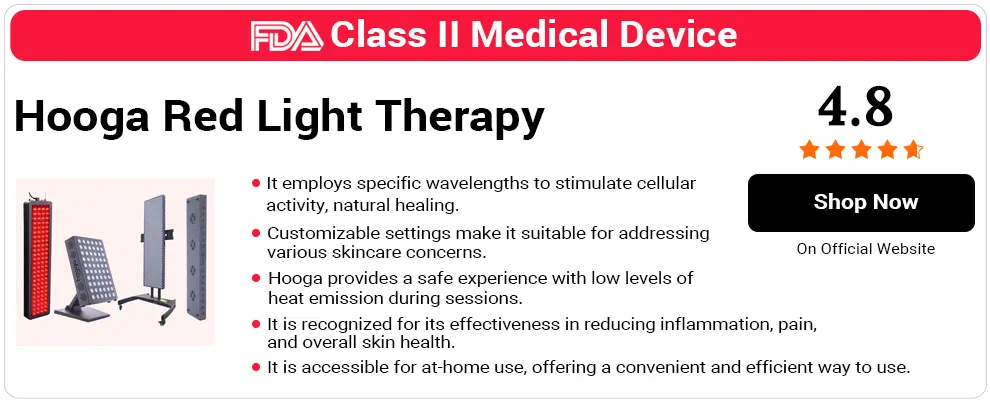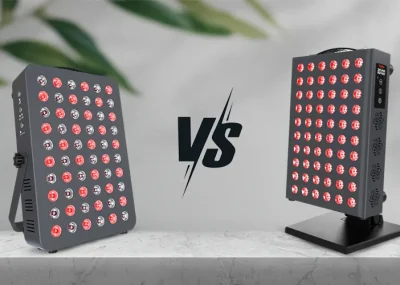What is Light Therapy and What Does it Do For You?
Light therapy is a technology which uses an artificial source of light or LED laser to penetrate the body, impacting the cells and promoting a wide variety of benefits to health and wellbeing. While in the past light therapy used to be available in dermatology clinics and salons exclusively, today there are a wide variety of devices for home use.
Light therapy is free of UV rays, and the LEDs offers different benefits depending on the color and wavelength, energy, and frequency. Some of the higher wavelengths like infrared light offer health advantages which may include reduction of pain, healing muscle tissue, improving exercise performance and recovery, and enhancing mood and brain health.
Lower wavelengths that fall into the category of visible light include violet, blue, orange, yellow, green, cyan and red. Blue and red light offer benefits for the skin in particular like reducing acne and signs of age, but they differ somewhat in their particular advantages.
We examine one red light product called the aduro led mask which benefits signs of aging, reduces acne and blemishes, and supports skin rejuvenation.
 LED light colors and associated frequencies and wavelengths
LED light colors and associated frequencies and wavelengthsBlue Light Therapy vs. Red Light Therapy
Blue and red light therapy both offer great benefits for skin health. Blue light is at a wavelength of 450–495 nm, and red light runs from 620–750 nm. Red light has a longer wavelength and lower energy than blue light, making it effective at tightening the skin and smoothing signs of age like wrinkles and fine lines.
However, compared to red light, blue light has higher frequency and is ideal for treating damaged skin and destroying harmful cells and bacteria without harming healthy areas. Blue light mostly treats the uppermost layers of skin, while red light delves a little deeper under the surface.
Research indicates that both blue and red light are both safe and minimally invasive, and do not expose you to harmful UV rays. Devices that emit these wavelengths are safe for both clinic and at home use, and offer great benefits for the complexion and for general health.
 Blue and red LED therapy wavelengths
Blue and red LED therapy wavelengthsWhat Makes Red Light and Blue Light Different?
Blue and red light differ in their wavelengths, energy, and frequency. LED blue light therapy delivers shorter waves than red light, but runs at a higher frequency and provides more photon energy. Red light has a longer wavelength but has lower frequency and energy levels compared to blue.
What Is Blue Light Therapy Used to Treat?
Blue LED light therapy works on the surface of the skin, killing harmful bacteria and decreasing inflammation. It’s ideal for healing and reducing acne, decreasing sun damage, and both preventing skin cancer development and healing precancerous cells.
In addition, blue light therapy may be effective at improving mood and could decrease the signs of depression, in particular if the low mood stems from seasonal affective disorder.
A study on male rats by Qinghe Meng, PhD, et al published in the Journal of Neuropathology and Experimental Neurology concluded that treatment with blue light may be effective as part of a treatment plan for decreasing depression [1].
Which Light Therapy Is Best for Wrinkles?
The most effective wavelengths for treating wrinkles and fine lines are in the red area of the spectrum. Red light therapy for skin leads to the production of additional collagen and elastin, which makes the skin tighter, more elastic, and smooths the surface to decrease the depth of wrinkles.
In addition, light therapy for skin with red wavelengths stimulates the release of added hyaluronic acid, a deeply hydrating agent which draws moisture. It helps eliminate dryness, and it also plumps the complexion for added volume.
A study in the Journal of the American Academy of Dermatology confirmed the benefits of red light therapy in heightening levels of collagen, elastin, and hyaluronic acid in the skin [2].
Research in Photomedicine and Laser Therapy by Alexander Wunsch and Karsten Matuschka showed its benefits in decreasing signs of age like wrinkles and lines [3].
According to the research, red light therapy for face is an ideal technology for promoting a younger looking complexion.
Dermatologist Dr. Maryam Zamani explains that red light therapy “boosts luminosity through improved circulation, calms redness, evens skin tone, and plumps up the complexion [4].”
Which Light Therapy Is Best for Acne?
While both red and blue light promote healing, research shows that blue wavelengths are best for treating acne. As it deals more with the top layer of skin, blue light is highly effective at killing damaging, acne-causing bacteria on the surface. There are various blue light led face mask that helps improve skin condition in cases of acne and blemishes
Blue light is also helpful for reducing inflammation in cells like keratinocytes, lessening the release of sebum from the sebaceous glands, and healing and preventing breakouts.
A study by Michael H Gold, MD, Anneke Andriessen, Julie Biron, and Hinke Andriessen in The Journal of Clinical and Aesthetic Dermatology showed that blue LED light is effective at healing mild to moderate acne breakouts [5].
Dermatologist Dr. Marnie Nussbaum explains, “Blue light has been shown to penetrate the skin’s hair follicles and pores, which harbor bacteria and can cause inflammation, and therefore acne. Bacteria are very sensitive to the blue light spectrum — it shuts down their metabolism and kills them [6].”
Which Light Therapy Is Best for Pain Relief?
The best light therapy wavelength for pain relief is infrared light, as it delves deep under the surface for profound healing and reduction of inflammation. In addition, it blocks key nerve receptors to decrease pain associated with conditions such as arthritis and muscle damage.
When comparing red and blue light therapy, you are better off using red to decrease pain as it penetrates more deeply. It’s most effective for issues like burns and musculoskeletal pain, as it provides energy to your cells to improve their ability to repair damage and decrease inflammation.
As we discussed in our review of another red light pain relief called Novaalab reviews, this helps in pain reduction and muscle growth.
How Often Should I Use My Red or Blue Light Therapy Device?
The general guidelines for the use of red and blue light therapy suggest that you should follow 15 minute sessions 3-5 times a week for a few months. However, this could differ depending on the issue you are treating and its severity, as well as for the specific panel you purchase.
Blue and red light therapy devices each offer their own protocol as to treatment time and length of use, and this will vary based on the problems you want to eliminate. It’s important to reads the user’s manual very carefully to make sure you are following the best and safest course of treatment for you.
We covered in tendlite reviews which benefits in reducing joint and muscle pain and also improves workout performance.
We Provide an Array of Light Therapy Devices That Can Help Relieve Your Problems
Explore our diverse collection of light therapy devices for a range of health issues, like pain relief and deep healing, repair of muscle tissue, improvements in mood and cognitive health, skin rejuvenation, boosting heart health, and strengthening the immune system.
The brands we recommend such as PlatinumLED Therapy Lights come in various sizes, from small, portable devices and skin care masks to full body panels and infrared heat lamps, and they deliver a range of colors and wavelengths. Read through our reviews and find the best choice for your health needs.
Any Side Effects?
Generally speaking, the research finds that LED blue and red light therapy wavelengths are safe, free of UV light, and should not lead to significant side effects.
However, when you purchase a device it’s important to make sure that it has zero or very low EMF levels, so there’s no exposure to harmful radiation.
In addition, the wavelength you choose for treatment is important, with 415 nanometers being optimal for blue light and 660 nanometers for red light.
If you notice any symptoms like too much redness or other unexpected issues during treatment, check with your dermatologist before continuing the process. Each person is different, therefore the light may have a different impact depending on the individual.
FAQs
Q: What Happens When You Mix Red And Blue Light?
A: Combining blue and red laser light therapy can be a very effective method for treating a range of issues, in particular as it pertains to serious skin conditions.
The blue light kills damaging bacteria and reduces inflammation, while the red light stimulates the release of added collagen and elastin for tighter, more elastic skin and less pronounced wrinkles and fine lines.
Dermatologist Joshua Zeichner, MD has said, “Red light has traditionally been used for anti-aging purposes because it helps stimulate collagen. At the same time, it helps reduce inflammation, which is why it is useful alongside blue light in treating acne [6].”
A 12 week clinical study published in the Journal of the American Academy of Dermatology confirmed Zeichner’s comments, showing that a combination of red and blue light helped treat mild to moderate acne [7].
Q: Which Has The Higher Frequency, Red Light or Blue Light?
A: Compared to red light, blue light has higher frequency even though it runs at shorter wavelengths, and it also offers higher energy levels.
Q: Is Red Light Therapy Good For Your Face?
A: Red light therapy has tremendous benefits for the face, as it promotes cell renewal for added health and rejuvenation. As we explained in our review of Biolight, it stimulates the release of collagen and elastin which makes the skin tighter and more elastic and smooths wrinkles and lines.
The LED red light therapy benefits also include promoting the synthesis of hyaluronic acid, which hydrates the complexion, eliminates dryness, and plumps to further diminish signs of age like wrinkles.
Q: Does Red Light Therapy Help Acne?
A: While red light therapy could have some impact on decreasing acne, it’s actually blue light that is ideal for this purpose. The blue wavelengths kill the harmful acne creating bacteria on the skin and reduce inflammation. Research shows its effectiveness in decreasing and preventing acne breakouts. Red and blue light combined are optimal for acne reduction.
Q: How Does Red Light Therapy Work?
A: Red laser therapy delivers photons into the skin, stimulating the mitochondria of the cells to produce higher levels of ATP (adenosine triphosphate). ATP powers all of the cells in the body, for tremendous benefits to the health of the body and skin.
Conclusion
Light therapy is a popular technology which is now very widely available for home use, and there are numerous quality, safe devices on the market that treat a number of health and skin issues successfully.
Blue and red light therapy differ somewhat in their properties, as red light offers wavelengths of about 620–750 nm and blue light runs at 450–495 nm and has a higher frequency and energy output than red. Blue light is particularly effective for treating acne, and may also have benefits for improving seasonal depression.
Red LED light for skin promotes skin rejuvenation, stimulates cell renewal, tightens the complexion, improves elasticity, and smooths wrinkles and lines. In addition, it offers other health benefits like pain reduction and healing wounds.
Research shows the safety and efficacy of wavelengths of red and blue light, and our site highlights a number of the top brands and devices which offer these wavelengths. When choosing a product, make sure to do your research to select the best device for your needs. For a wide range of choices, explore our article on the FDA approved red light therapy devices for pain.













